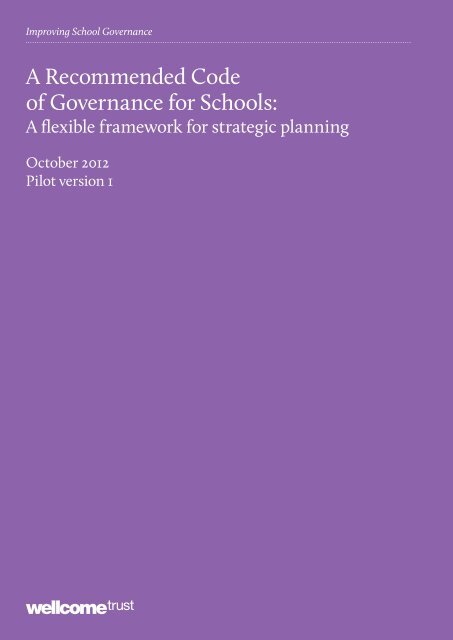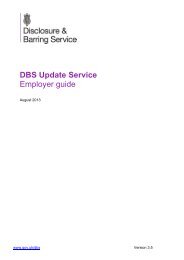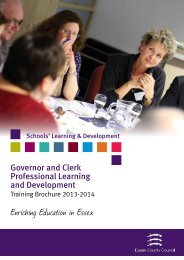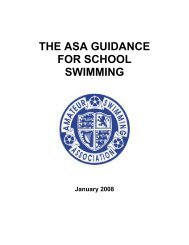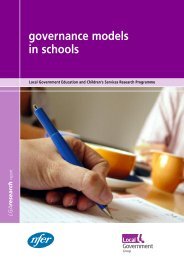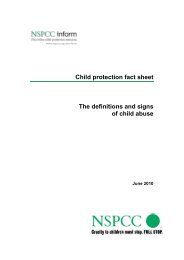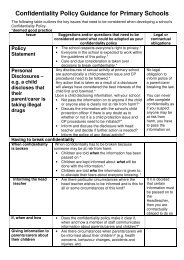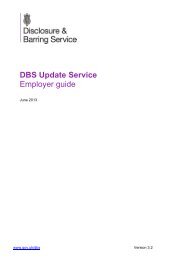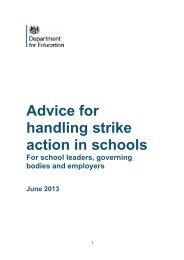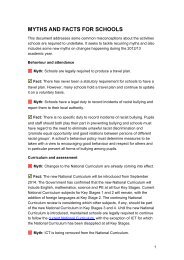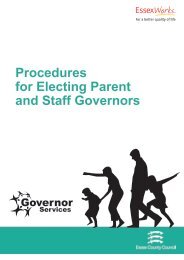A Recommended Code of Governance for Schools: - Wellcome Trust
A Recommended Code of Governance for Schools: - Wellcome Trust
A Recommended Code of Governance for Schools: - Wellcome Trust
You also want an ePaper? Increase the reach of your titles
YUMPU automatically turns print PDFs into web optimized ePapers that Google loves.
Improving School <strong>Governance</strong>A <strong>Recommended</strong> <strong>Code</strong><strong>of</strong> <strong>Governance</strong> <strong>for</strong> <strong>Schools</strong>:A flexible framework <strong>for</strong> strategic planningOctober 2012Pilot version 1Improving School <strong>Governance</strong> | 1
Improving School <strong>Governance</strong> | 2
Improving School <strong>Governance</strong>ForewordThis pilot version <strong>of</strong> the <strong>Recommended</strong> <strong>Code</strong> <strong>of</strong> <strong>Governance</strong><strong>for</strong> <strong>Schools</strong> was produced in October 2012 and is now being<strong>for</strong>mally evaluated in 21 schools – primary, secondary andspecial – across England. The partners we worked with, andthe sources on which we drew in developing this<strong>Recommended</strong> <strong>Code</strong>, are listed in the Appendix.Since launching the <strong>Recommended</strong> <strong>Code</strong>, we have had manyrequests <strong>for</strong> copies <strong>of</strong> it from schools outside the <strong>for</strong>mal pilot.We are pleased to make this pilot version available and wouldbe very interested to receive comments and feedback, whichshould be sent to h.baker@wellcome.ac.uk.Download a PDF <strong>of</strong> the report, or order print copies <strong>for</strong> free,from our website:www.wellcome.ac.uk/recommendedcodeSir John HolmanSenior Fellow <strong>for</strong> Education at the <strong>Wellcome</strong> <strong>Trust</strong>January 2013Improving School <strong>Governance</strong> | 3
Improving School <strong>Governance</strong>A <strong>Recommended</strong> <strong>Code</strong><strong>of</strong> <strong>Governance</strong> <strong>for</strong> <strong>Schools</strong>:A flexible framework <strong>for</strong>strategic planningWhy a <strong>Recommended</strong> <strong>Code</strong> <strong>of</strong> <strong>Governance</strong>?<strong>Schools</strong> are beset by so many regulations and reportingrequirements that it can be difficult to see the wood <strong>for</strong> thetrees. To help school governors and senior leaders take abroader and longer-term perspective, we have developed this<strong>Recommended</strong> <strong>Code</strong> <strong>of</strong> <strong>Governance</strong>. The aim is to givegovernors and senior leaders a robust framework that theycan use to set the strategic direction <strong>for</strong> their school, and thatgovernors can use to hold the senior leaders to account.The idea <strong>of</strong> a <strong>Recommended</strong> <strong>Code</strong> <strong>of</strong> <strong>Governance</strong> (referred toas the “<strong>Recommended</strong> <strong>Code</strong>” throughout) is based on the UKCorporate <strong>Governance</strong> <strong>Code</strong> (see Appendix) and on practicein charitable foundations, where the Statement <strong>of</strong><strong>Recommended</strong> Practice provides a framework <strong>for</strong> annualreporting which is sufficiently flexible to accommodatediverse organisations.This is a pilot version <strong>of</strong> the <strong>Recommended</strong> <strong>Code</strong>, <strong>for</strong> usefrom autumn 2012. It is a starting-point <strong>for</strong> schools to buildon as needed.We appreciate that many schools already have a <strong>Code</strong> <strong>of</strong>Practice – quite possibly based on the National Governors’Association’s models – in which case this <strong>Recommended</strong><strong>Code</strong> could be used as a starting-point <strong>for</strong> the furtherdevelopment <strong>of</strong> the existing <strong>Code</strong> <strong>of</strong> Practice, rather than as atemplate <strong>for</strong> starting from scratch.The Appendix describes how this <strong>Recommended</strong> <strong>Code</strong> wasdeveloped. The pilot <strong>of</strong> the <strong>Recommended</strong> <strong>Code</strong> is beingorganised in partnership with the National Governors’Association and National Leaders <strong>of</strong> <strong>Governance</strong>.Overall structure <strong>of</strong> the <strong>Recommended</strong> <strong>Code</strong>The <strong>Recommended</strong> <strong>Code</strong> has three elements:Element AA shared vision and long-termstrategic plan <strong>for</strong> the school,from which annual schooldevelopment plans can bederived, with the governing bodymonitoring these plans.Element BA framework <strong>for</strong> governance,setting out how the governingbody is expected to function.Comprising: skills, effectiveness,strategy, engagement, the role <strong>of</strong>the chair and the accountability<strong>of</strong> the executive.Element CHigh-level school per<strong>for</strong>manceindicators, encompassing alloutcomes <strong>for</strong> an effective school,on which governors reportannually to parents.Linked to the high-levelper<strong>for</strong>mance in<strong>for</strong>mation thatgovernors need to monitor theper<strong>for</strong>mance indicators.The <strong>Recommended</strong> <strong>Code</strong> is intended to be flexible enough toallow schools to exercise autonomy, yet robust enough toenable governors to hold the executive to account.The <strong>Recommended</strong> <strong>Code</strong> set out here is a starting-point thateach school will develop to suit its own situation and needs.4 | Improving School <strong>Governance</strong>
Improving School <strong>Governance</strong>Element AA shared vision and long-term strategic plan <strong>for</strong> the school,from which annual school development plans can be derived,with the governing body monitoring these plans.<strong>Schools</strong> need to have a long-term strategy, based on a sharedvision. It is the job <strong>of</strong> governing bodies, working with theheadteacher and senior leaders, to agree a strategic plan <strong>for</strong>the coming three to five years. It is then the job <strong>of</strong> the seniorleaders to turn the strategic plan into a school developmentplan, updated each year, and to implement this in practice.Strategic planAgreed by governors andsenior leaders.School development planDeveloped by senior leadersbased on the strategic plan.Implementation in practiceDone by senior leaders andstaff.Setting out the vision <strong>for</strong>the school and its broadambitions.►With details <strong>of</strong> how thestrategy will be turned intoreality.►Monitored by governors.Developed in discussion withteachers, parents and learners.The line between governance and managementIt is important that governors understand where the line liesbetween their strategic responsibilities and the managementresponsibilities <strong>of</strong> the headteacher and senior leaders.Stepping over that line is inappropriate and can make theheadteacher’s job harder.• implementation <strong>of</strong> delegated financial responsibility,checks and balances• behaviour policy and its implementation• policy <strong>for</strong> deployment <strong>of</strong> resources – including buildingsand equipment.More detailed guidance can be found in What governingbodies should expect from school leaders and what school leadersshould expect from governing bodies (see Appendix).Even so, governors need to agree how the school willimplement its strategic plan in practice, and they need tomonitor how it is doing so. Governors may be particularlyinterested in monitoring the following:• recruitment, retention and training <strong>of</strong> specialist andnon-specialist staff, both teaching and non-teaching• per<strong>for</strong>mance management <strong>of</strong> staffImproving School <strong>Governance</strong> | 5
Improving School <strong>Governance</strong>Element BA framework <strong>for</strong> governance, setting out how the governingbody is expected to function. Comprising: skills, effectiveness,strategy, engagement, the role <strong>of</strong> the chair and theaccountability <strong>of</strong> the executive.The governing body has three core functions <strong>for</strong> the school:• setting the strategic direction• holding the headteacher to account <strong>for</strong> improving the school• ensuring financial health, probity and value <strong>for</strong> money.These core functions are consistent with the criteria thatOfsted will use to judge the governing body (see paragraph 60<strong>of</strong> Ofsted’s Framework <strong>for</strong> School Inspection, September 2012,and further detail in the Inspection Handbook, pages 43–44).To meet these expectations, the governing body needs to agreesome broad principles about the way it works. In this element<strong>of</strong> our <strong>Recommended</strong> <strong>Code</strong>, these principles are captured hereby the following set <strong>of</strong> questions (a slightly modified version <strong>of</strong>Twenty key questions <strong>for</strong> a school governing body to ask itself – seeAppendix):Right skills: Do we have the right skills onthe governing body?1. Have we completed a skills audit <strong>of</strong> our governing body?2. Do we appoint governors on the basis <strong>of</strong> their skills, and dowe know how to find people with the right skills?Effectiveness: Are we as effective as we could be?3. Do we understand our roles and responsibilities?4. Do we have a pr<strong>of</strong>essional clerk and run meetingsefficiently?5. What is our training and development budget and doesevery governor receive the support they need to carry outtheir role effectively?6. Do we know about good practice from across the country?7. Are the size, composition and committee structure <strong>of</strong> ourgoverning body conducive to effective working?8. Does every member <strong>of</strong> the governing body make a regularcontribution?Accountability <strong>of</strong> the executive:Do we hold the school leaders to account?11. Do we understand the school’s per<strong>for</strong>mance data wellenough to properly hold school leaders to account?12. How effective is our per<strong>for</strong>mance management <strong>of</strong> theheadteacher?13. Are our financial management systems robust and how dowe ensure best value <strong>for</strong> money?Engagement: Are we properly engaged with ourschool community, the wider school sector andthe outside world?14. How do we listen to and understand our pupils, parentsand staff?15. How do we report to our parents and local communityregularly?16. What benefit do we draw from collaboration with otherschools and other sectors, locally and nationally?Role <strong>of</strong> the chair: Does our chair show strongand effective leadership?17. Do we carry out an annual review <strong>of</strong> the chair’sper<strong>for</strong>mance?18. Do we engage in good succession planning?19. Are the chair and committee chairs re-elected each year?Impact: Are we having an impact on outcomes <strong>for</strong> pupils?20. How much has pupil progress improved over the last threeyears, and what has the governing body’s contributionbeen to school improvement?Strategy: Does the school have a clear strategy?9. Have we set an ambitious strategic plan, how do wemonitor it and when did we last review it?10. Does our strategic planning and reviewing cycle drive thegoverning body’s activities and agenda setting?6 | Improving School <strong>Governance</strong>
Improving School <strong>Governance</strong>Element CHigh-level school per<strong>for</strong>mance indicators, encompassing all outcomes<strong>for</strong> an effective school, on which governors report annually to parents.Linked to the high-level per<strong>for</strong>mance in<strong>for</strong>mation that governorsneed to monitor the per<strong>for</strong>mance indicators.The per<strong>for</strong>mance indicators will be agreed in detail betweenthe governing body and the senior leaders, based on a sharedvision <strong>of</strong> what the school is aiming to achieve (Element A).Some examples <strong>of</strong> high-level outcomes are in the table below.Note that some apply to all phases, while others are specificto primary or secondary. These are only suggestions, andeach school can select from them and add others asappropriate.Not all the per<strong>for</strong>mance measures are quantitative: some <strong>of</strong> themost important outcomes do not lend themselves to simplequantitative measurement. Outcomes will be monitoredthrough a combination <strong>of</strong> narrative and quantitative measuresappropriate to the phase and type <strong>of</strong> school.For some <strong>of</strong> the measures, there will be limited external datato compare with or use as benchmarks; in these cases,schools should be able to learn from tracking their ownper<strong>for</strong>mance over time.Outcomes that are more subjective may seem hard tomeasure. One example <strong>of</strong> a way to approach these is NewPhilanthropy Capital’s eight ‘aspects <strong>of</strong> well-being’:www.well-beingmeasure.com/aspects-<strong>of</strong>-well-beingImproving School <strong>Governance</strong> | 7
Improving School <strong>Governance</strong>Element C (continued)High-level school per<strong>for</strong>mance indicators, encompassing all outcomes<strong>for</strong> an effective school, on which governors report annually to parents.Linked to the high-level per<strong>for</strong>mance in<strong>for</strong>mation that governorsneed to monitor the per<strong>for</strong>mance indicators.School per<strong>for</strong>mance indicatorDo learners at this school achieve to their potential?Are learners at this school inspired by their teachers?Do learners at this school have high aspirations?Do learners enjoy coming to this school?Are relationships among learners good at this school?Are learners at this school self-confident?Do learners at this school have multiple opportunitiesto experience success?Are learners from this school employable?Does the school have good community relations?• Is the school outward-facing in the community?• Does it support the community, and does thecommunity support it?Are learners taught in a healthy and safe environment?Examples <strong>of</strong> per<strong>for</strong>mance in<strong>for</strong>mation <strong>for</strong> measurement(Primary) KS2 numeracy and literacy points score distribution(Secondary) Distribution <strong>of</strong> GCSE points score across best eightsubjects(Special schools) Progress against appropriate measuresRAISEonline and Fischer Family <strong>Trust</strong> dataTo be decided as part <strong>of</strong> the pilotPossibilities include:• proportion <strong>of</strong> learners choosing to continue to study the subjectsthey learn at school• parents’ ratings <strong>of</strong> how likely they would be to recommendthe school• Ofsted data about teaching quality• objective surveys commissioned from an external provider.Proportion applying <strong>for</strong> degree programmes at colleges anduniversities (including elite universities) and <strong>for</strong> apprenticeshipsAttendance ratesParent and learner surveysTo be decided as part <strong>of</strong> the pilotTo be decided as part <strong>of</strong> the pilotRange <strong>of</strong> opportunities available at the school (music, drama, sport,dance etc.) in addition to academic opportunitiesProportion <strong>of</strong> learners taking part in such opportunitiesQuality <strong>of</strong> facilities <strong>for</strong> extracurricular activitiesProportion in education, training or employment three years afterleavingTo be decided as part <strong>of</strong> the pilotCould include ratio <strong>of</strong> applications to placesTo be decided as part <strong>of</strong> the pilotCould include per<strong>for</strong>mance against ‘Healthy <strong>Schools</strong>’ criteria8 | Improving School <strong>Governance</strong>
Improving School <strong>Governance</strong>Element C (continued)High-level school per<strong>for</strong>mance indicators, encompassing all outcomes<strong>for</strong> an effective school, on which governors report annually to parents.Linked to the high-level per<strong>for</strong>mance in<strong>for</strong>mation that governorsneed to monitor the per<strong>for</strong>mance indicators.Annual reportingThere is no statutory requirement <strong>for</strong> schools to report annually to parents, but it is very goodpractice to do so. The per<strong>for</strong>mance indicators are a good basis <strong>for</strong> reporting to parents.During the pilot we intend to collect examples <strong>of</strong> different ways that schools report to parents.Per<strong>for</strong>mance in<strong>for</strong>mationGovernors need data and in<strong>for</strong>mation to help them judgehow well the school is per<strong>for</strong>ming against the criteria that thegoverning body and senior leaders have agreed. Questionsthat governors might ask include:• Do we have ready access to all the data and in<strong>for</strong>mation weneed to monitor the per<strong>for</strong>mance indicators?• Are we able to access that in<strong>for</strong>mation independently, or dowe depend on the senior leaders to provide or interpret it<strong>for</strong> us?• Is the in<strong>for</strong>mation at the right level <strong>of</strong> detail – detailedenough to tell us what we need to know, but not so detailedas to make it difficult to see the wood <strong>for</strong> the trees?• Is in<strong>for</strong>mation available on all the aspects <strong>of</strong> the school’sper<strong>for</strong>mance that we agree are important – or only on thoseaspects that are easy to measure?• Are we able to use benchmarking data to compare theschool’s per<strong>for</strong>mance with that <strong>of</strong> comparable schools (notonly local ones)?As part <strong>of</strong> the pilot, we are planning to develop an associatedsystem <strong>for</strong> providing in<strong>for</strong>mation to governors. More detailswill become available as this work develops.Improving School <strong>Governance</strong> | 9
Improving School <strong>Governance</strong>Appendix: How this pilot version <strong>of</strong> the<strong>Recommended</strong> <strong>Code</strong> was developedThis pilot version arises from two workshops held at the<strong>Wellcome</strong> <strong>Trust</strong> in March and June 2012, attended bygovernors, headteachers, and representatives <strong>of</strong> theDepartment <strong>for</strong> Education, Ofsted, the National GovernorsAssociation, the National College <strong>for</strong> School Leadership,School Governors’ One-Stop Shop and other stakeholders.The idea <strong>of</strong> a <strong>Recommended</strong> <strong>Code</strong> <strong>of</strong> <strong>Governance</strong> is based onthe UK Corporate <strong>Governance</strong> <strong>Code</strong> and on practice incharitable foundations, where the Statement <strong>of</strong><strong>Recommended</strong> Practice provides a framework <strong>for</strong> annualreporting that is sufficiently flexible to accommodate diverseorganisations.This <strong>Recommended</strong> <strong>Code</strong> draws on the following sources.The UK Corporate <strong>Governance</strong> <strong>Code</strong> (Financial ReportingCouncil, June 2010). It provides a recommended governancecode <strong>for</strong> FTSE 350 companies. www.frc.org.uk/Our-Work/<strong>Code</strong>s-Standards/Corporate-governance.aspxTwenty key questions <strong>for</strong> a school governing body to ask itself(All-Party Parliamentary Group on School <strong>Governance</strong> andLeadership, May 2012). www.nga.org.uk/Resources/Useful-Documents/Twenty-Key-Questions.aspxWhat governing bodies should expect from school leaders andwhat school leaders should expect from governing bodies(Association <strong>of</strong> School and College Leaders, NationalGovernors’ Association, National Association <strong>of</strong>Headteachers). www.nga.org.uk/About-Us/Be-a-Governor/In<strong>for</strong>mation-<strong>for</strong>-governors.aspx<strong>Code</strong> <strong>of</strong> Practice <strong>for</strong> Academy School Governors (NationalGovernors’ Association, 2011). www.nga.org.uk/Resources/Useful-Documents/<strong>Code</strong>-<strong>of</strong>-Practice.aspxStatements <strong>of</strong> Intended Impact (Teach First, 2012).Good governance: Proposals from the 2012 FellowshipCommission (National College <strong>for</strong> School Leadership).This draft was prepared by a small working partycomprising: Paul Charman, Chair, Dyson Perrins School andRM; Helen Drake, Governor, Martin Primary School; MartinPost, Head, Wat<strong>for</strong>d Grammar School <strong>for</strong> Boys; EmlynSamuel, <strong>Wellcome</strong> <strong>Trust</strong>; John Holman, <strong>Wellcome</strong> <strong>Trust</strong>. Ithas been revised following review by the National Governors’Association, the National College <strong>for</strong> School Leadership andseveral National Leaders <strong>of</strong> <strong>Governance</strong>.10 | Improving School <strong>Governance</strong>
Improving School <strong>Governance</strong> | 11
This work is © the <strong>Wellcome</strong> <strong>Trust</strong> andis licensed under Creative CommonsAttribution 2.0 UK.The future <strong>of</strong> science depends on the quality<strong>of</strong> science education today.We are a global charitable foundation dedicatedto achieving extraordinary improvements inhuman and animal health. We support thebrightest minds in biomedical research and themedical humanities. Our breadth <strong>of</strong> supportincludes public engagement, education and theapplication <strong>of</strong> research to improve health.We are independent <strong>of</strong> both political andcommercial interests.<strong>Wellcome</strong> <strong>Trust</strong>Gibbs Building215 Euston RoadLondon NW1 2BE, UKT +44 (0)20 7611 8888F +44 (0)20 7611 8545E contact@wellcome.ac.ukwww.wellcome.ac.ukThe <strong>Wellcome</strong> <strong>Trust</strong> is a charity registered in England and Wales,no. 210183. Its sole trustee is The <strong>Wellcome</strong> <strong>Trust</strong> Limited, a companyregistered in England and Wales, no. 2711000 (whose registered <strong>of</strong>ficeis at 215 Euston Road, London NW1 2BE, UK). SP-5558.2/1-2013/MC


